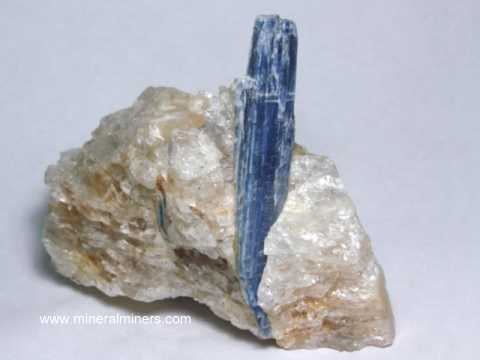Go Up to our Kyanite Information Index
Kyanite Chemical composition: Al2 SiO5
Class: nesosilicate
Kyanite Crystal system: triclinic
Kyanite Crystal habit: crystals commonly occur as tabular prismatic crystals elongated
on c , kyanite crystals can be wavy, folded, in bladed agregates, rarely terminated.
Twinning: multiple twinning common on {100}
Kyanite Specific gravity: 3.55 - 3.66
Index of refraction: 1.712 - 1.734
Birefringence: moderate (0.012-0.016)
Kyanite Pleochroism: strong: colorless/violet-blue/cobalt blue
Hardness: 4.5 to 5 parallel to crystal length, 7 to 7.5 perpendicular to length
Kyanite Color: kyanite usually occurs in shades of blue, also white, gray to black, yellow, green
or colorless, often with irregular color zoning.
Luster: vitreous to pearly
Kyanite Transparency: Kyanite Crystals are translucent to transparent
Cleavage: perfect on {100} and distinct on {010}
Kyanite Fracture: splintery to fibrous
Streak: white
Go Up to our Kyanite Information Index
There are three polymorphs of Al2 SiO5 :
andalusite , kyanite sillimanite . Each of these minerals has the
same chemical composition but differing crystal structure.
These three minerals form in
aluminous metamorphic rocks. The temperature and pressure are what determines
which of these polymorphs will crystallize. Knowing the pressure and temperature
stability field for each of these three minerals can be of significant value
in understanding metamorphic terrains.
Under conditions of high temperature regional metamorphism, sillimanite
tends to occur from rocks of appropriate composition. Kyanite crystals Andalusite
is indicative of relatively low pressure conditions of formation, often occuring in
contact metamorphic deposits.
Go Up to our Kyanite Information Index
Kyanite crystals most often form in high pressure regionally metamorphosed
aluminous rocks and in the quartz veins that cut through them, associated with
quartz , muscovite mica ,
almandine garnet , biotite, staurolite and corundum .
It also occurs in some kimberlite pipes and eclogites
associated with pyrope garnet and omphacite.
The blue color in metamorphic kyanite is due to trace amounts of Fe+2
and Ti+4 impurities substituting for aluminum. The light blue color
of kyanites found in kimberlites is due to trace amounts of chromium.
Kyanite is characterized by its blue color, differing hardnesses in different directions, perfect
cleavage, and the blade-like form of Kyanite Crystals .
Go Up to our Kyanite Information Index
kyanos , meaning blue.
Ground up kyanite crystals are used in the manufacture of spark plugs and other heat resistant ceramics.
Kyanite gemstones of fine color and transparency
are rare. Because kyanite's well developed
cleavage and relatively low hardness and make it comparatively easy to damage, the use of kyanite as a gemstone is
limited mostly to pendants, earrings, and necklaces.
The astrological signs of kyanite are Aires, Taurus, and Libra.
Go Up to our Kyanite Information Index
Wearing kyanite jewelry (or holding a Kyanite Crystal ) is said to be very useful in enhancing one's creativity, broadening
one's perspective, and in reaching a better understanding with others. Kyanite
is also said to bring calm and tranquility, and to facilitate meditation.
Kyanite is said to help clear sinus congestion, and to help in the treatment
of muscular disorders.
For more in-depth metaphysical information, see our Metaphysical Books section.
Go Up to our Kyanite Information Index
Kyanite For Sale In Our On-line Store:
Go to the Top of this Kyanite Info page
Last Updated: September 30, 2025© Copyright 1998-2023 Gem & Mineral Miners, Inc.® All Rights Reserved.




